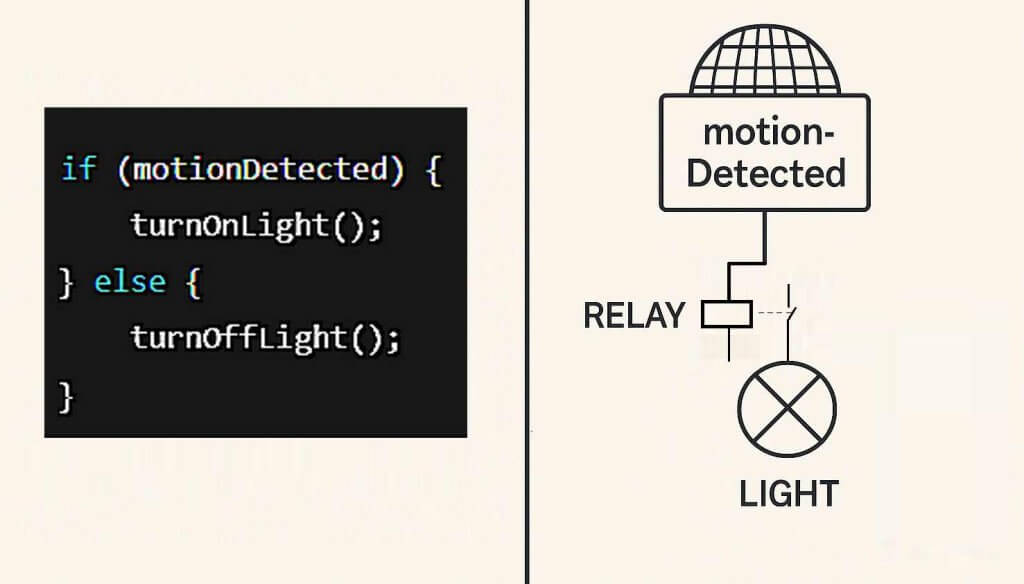💡 Can’t Grasp How Programming Works? Think of It Like Wiring a Light Switch
If you have trouble understanding the essence of programming — what code really does — try thinking about it like electricity. Not the scary kind from physics class, but something you already know: a light switch in your room. Or a motion sensor that turns the hallway light on when someone walks by.
That’s logic. And logic is the heart of programming.
You flip a switch → the light turns on. No magic. Just input → action. That’s exactly how a program works too.

Let’s keep going.
Programming = Electronics, Just Without the Wires
Believe it or not, programming and applied electronics are deeply similar. Here’s how they match up:
| Programming Concept | Electronics Equivalent |
|---|---|
| Code / Algorithm | Circuit Diagram |
| Function / Module | Component (Resistor, Transistor) |
| Function Call / Trigger | Signal Through a Wire |
| Data Processing / Branching | Relay Switching / Circuit Logic |
| States, Flags | Voltage Levels (High/Low) |
| Runtime Errors / Bugs | Short Circuit / Wrong Wiring |
| Debugging | Using a Multimeter or Oscilloscope |
How to Picture It
A program is like a logical circuit. Instead of wires and electricity, we use variables and data flows.
Functions are like circuit blocks: they receive input, transform it, and give output.
Even the way we build apps — with different layers (like frontend, backend, database) — is just like building a device from blocks: display, control board, power unit.
In other words, when you’re writing code, you’re designing a system, just like you would with components and wires.
Diagrams in Programming? They’re Just Schematics
Visual learners, this one’s for you.
Programming diagrams are often direct analogs of electrical schematics:
- Class diagrams (UML) = connections between circuit blocks
- Sequence diagrams = timing diagrams of signals
- State machines = logic of triggers, just like timers and relays
- Flowcharts = the exact same thing as schematic logic flow
If you’ve ever followed a line through a circuit, step by step, you already know how to trace logic in code.
Already in Electronics or Electrical Work?
Good news: you’re halfway there. You already know what a relay does. You’ve seen input and output in the real world. You’ve wired logic — now you just need to write it.
And if you’ve never touched electronics? No worries. You still understand what happens when you flip a switch. That’s all the intuition you need.
Programming is just taking that logic — and making it more flexible, more detailed, and more scalable.
Want to Get Started?
If you’re curious to try programming with this mindset, here’s what can help:
- “Code” by Charles Petzold — a beautiful journey from Morse code to computers
- Arduino starter kits — combine hardware and software in fun little projects
- Simple logic gate tutorials — they’ll feel strangely familiar if you’ve done electrical work
💬 Final Thought
Programming isn’t about memorizing syntax. It’s about understanding what causes what. Just like in a circuit.
So whether you’ve been connecting wires or simply flipping light switches — you already think like a programmer.
Now it’s just a matter of putting it into words… or rather, into code.

Interesting article. It would be good to tell this in the first lesson, so that there is no “feeling of an impostor”.